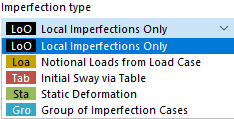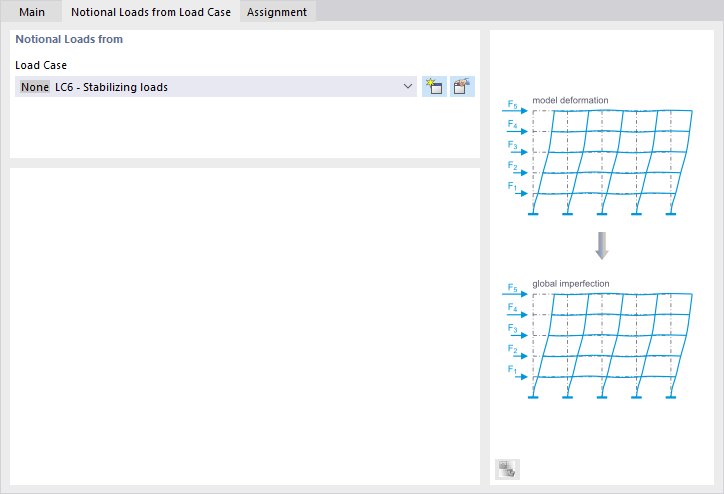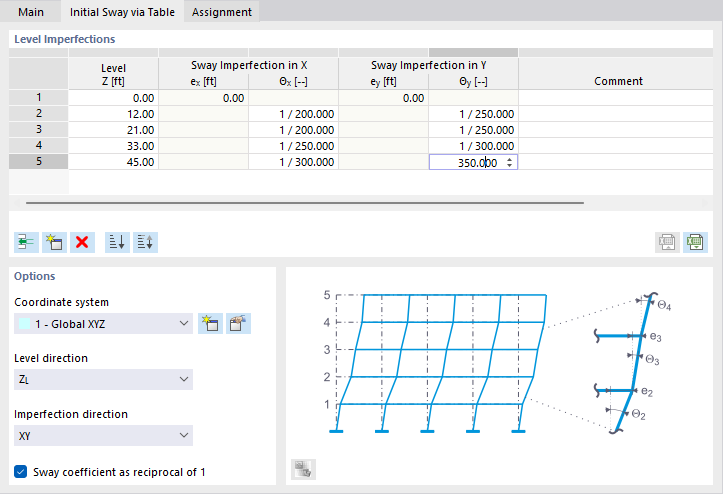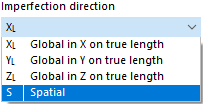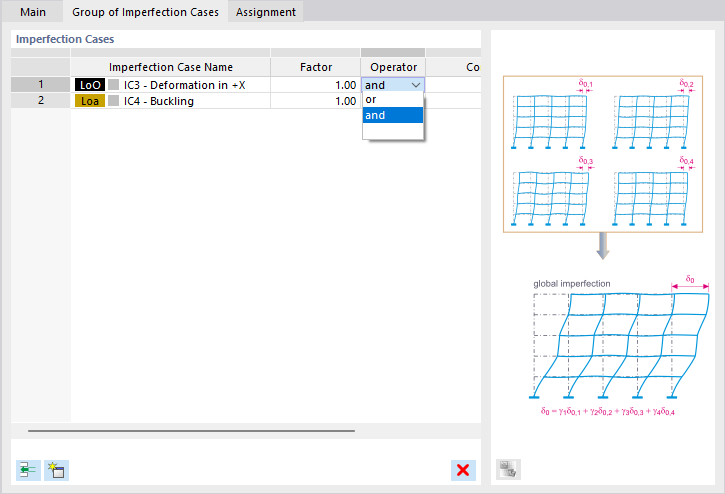Imperfection cases describe the basic conditions of imperfections. Use them to define whether geometric imperfections or equivalent loads should be taken into account. Corresponding specifications can be found in the individual standards.
Main
The Main tab controls the type of imperfection. Imperfections can be taken into account, for example, in the form of equivalent loads, geometric pre-deformations, or inclinations by story.
In the Assignment tab, you can assign the imperfection case to specific load cases and combinations.
Settings
Various imperfection types are available for selection in the list.
Local Imperfections Only
Imperfections are represented by equivalent loads. The inclinations and precambers depend on normal forces. You can define those imperfections in the Local Imperfections navigator category for members and member sets.
Notional Loads from Load Case
Imperfections are based on the loads of a particular load case. You can assign this load case in the Notional Loads from Load Case tab or create a new one.
Initial Sway via Table
This type of imperfection allows you to represent imperfections by story. Define the parameters in the Initial Sway via Table tab.
Static Deformation
Imperfections are based on the deformations of a load case or combination. Define the governing parameters in the Static Deformation tab.
In the "Source type" list, select whether the displacements are based on a load case or a load combination.
Group of Imperfection Cases
This imperfection type allows you to combine specifications from several imperfection cases. You can group the imperfection cases in the Group of Imperfection Cases tab and scale them by factors.
Options
The "Assign to all load combinations without assigned imperfection case" check box is activated by default. This option ensures that the imperfection case is taken into account for all load combinations that are not included by manual selection in the Assignment tab.
Example
In the "Assignment" tab, the "Wind" load case is assigned manually. Thus, all load combinations using this load case are assigned automatically. For load combinations without wind, however, the imperfection case is only considered if the "Assign to all load combinations without assigned imperfection case" option is activated.
Notional Loads from Load Case
Notional loads are available as an imperfection type (see the image Selecting Imperfection Type).
You can describe those imperfections in a load case by equivalent loads. Assign the None load case category to this load case so that it is not considered in the combinatorics, but only as an imperfection load case. This way, you can define, for example, stabilizing loads independently of normal forces - in contrast to inclinations or "notional loads", which act as equivalent loads related to normal forces.
Select the load case in the list, or create a new load case with the
![]() button.
button.
Initial Sway via Table
The Initial Sway is available as an imperfection type (see the image Selecting Imperfection Type).
Level Imperfections
You can describe the normative displacement of a building in a table. Thus, you do not need to define imperfections for each individual column. The floor levels of the table control how nodes are moved within the building sections.
Define the ordinates of the stories and assign the inclinations. Use the
![]() button to add rows. Make sure that the ordinates are set in ascending order. Based on these specifications, RFEM determines a geometric displacement and applies it to the FE nodes.
button to add rows. Make sure that the ordinates are set in ascending order. Based on these specifications, RFEM determines a geometric displacement and applies it to the FE nodes.
Options
If the imperfections are not to be related to the global XYZ coordinate system, you can select a user-defined "Coordinate system" or create a new one. The "Level direction" specifies the ordinate of the stories; thus, vertically oriented initial sways are also possible.
The "Imperfection direction" defines the direction(s) in which inclinations are applied. With "XY" as the default setting, inclinations in the table are specified for the directions X and Y. If they act in only one direction, define the corresponding axis in the list.
In the table, the "Sway coefficient" is displayed "as a reciprocal of 1". If you deactivate the check box, the values appear as decimal numbers.
Static Deformation
The Static Deformation is available as an imperfection type (see the image Selecting Imperfection Type).
The "Imperfection Shape" is based on the deformations of a load case or combination. The geometric pre-deformations are scaled to a magnitude.
Imperfection Shape from
Select the governing load case or combination in the list. Use the
![]() button to create a new load case or combination.
button to create a new load case or combination.
Imperfection Magnitude
The "Reference location" defines the location in the model whose displacement serves as a reference for the sagitta. Usually, this is the location with the greatest displacement. However, you can also select another node in the list or define it graphically with the
![]() button.
button.
If the imperfections are not to be related to the global XYZ coordinate system, you can select a user-defined "Coordinate system" or create a new one. The "Imperfection direction" defines the orientation of imperfections. The "S" option allows for imperfections that are spatial, such as those occurring in shell models.
Enter the "Imperfection magnitude" that represents the maximum geometric displacement. The displacements of the FE nodes are scaled to this value. The deformation of the load case or combination specified above forms the basis.
Group of Imperfection Cases
The Group of Imperfection Cases is available as an imperfection type (see the image Selecting Imperfection Type).
You can combine several imperfection cases in one group and thus consider them at the same time. This option is often useful for shell buckling in order to apply global imperfections and local buckling.
Define the imperfection cases to be combined. Use the
![]() button to add rows to the table.
button to add rows to the table.
You can apply a "Factor" to each imperfection case. Use the "Operator" to define whether the imperfection cases act simultaneously ("and") or are mutually exclusive ("or").
Assignment
In the Assignment tab, you can assign one or more load cases or load combinations to the imperfection case. Only then is the imperfection case considered in the calculation.
Assign
The "To Assign" column lists all the load cases you have created. To transfer a load case to the "Assigned Objects" list, you can use the following possibilities:
- Double-click the load case.
- Select the load case. Then, click the
 button.
button.
Assigned Objects
The "Assigned Objects" column manages all load cases that you assign to the imperfection case. For example, if you want to consider the imperfection case "Wind in +X" by the load case "Wind in +X", transfer this load case to the list as described above. If the Combination Wizard is active, all load combinations using this load case are assigned, too.
This way, you can compare imperfection cases with the acting directions of load cases: For example, an imperfection case with inclinations in X acts for wind loading in X; an imperfection case in Y, for wind loading in Y. For unassigned load combinations (those without wind loads), each imperfection case is considered separately. RFEM creates two load combinations each with identical superposition criteria, but different imperfection cases.

